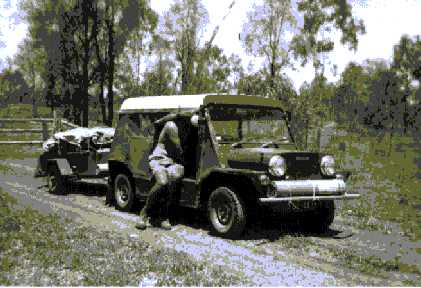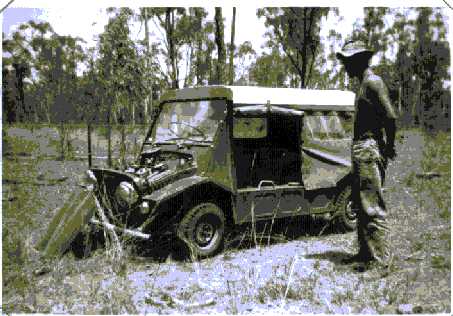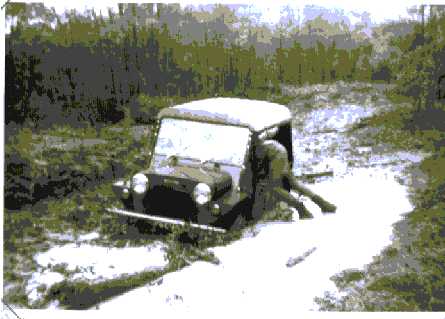|
SURVEYING IN A MOKE
by Bob Ward.
A short story of surveying the outback in a Moke
.
Being a Surveyor in the early to mid 60’s in Queensland was a wonderful time to recall. Surveying as a profession was coming out of the dark ages and was grasping the first of our modern technology. Being employed by a Survey group which had just won the contract to aerial map half of Queensland for the burgeoning coal industry, and had the foresight to purchase, arguably ,two of the first Mokes sold in Queensland for this project, to a 19 year old who owned a 1964 Mini, this was just heaven on a stick.
I was given the task of being custodian of one of the two (PGE-447), before the survey started and was required to “run it in” before the job. This of course was like feeding strawberries to pigs, so with great excitement, I delivered myself in the winter of 1966 to the BMC workshop in north Brisbane and took delivery of the two brand new dark green 998cc Mokes.
My Company had requested roof protection rather than using the vinyl curtain style, so the BMC boffins came up with a “tin hat” painted white, which in the course of events, only served to keep the sun out and thwart the attention of angry motorcyclists.
The interior was exceptionally spartan with 2 black vinyl seats strung between metal frames. The Moke was designed in “buckboard”style and was great for storing equipment in the back. The fuel tank on the left of the passenger with its large filler cap, was a bit of a problem if you were a smoker, as the fuel used to slosh along the sideboard in the various terrain. 4 x 10” tyres at each corner completed the package - no rear washers or wipers for this model. With the tin roof, talking in the vehicle was like being a bat in a belfry, and any speed over 60mph created a combination of slipstream, engine and tyre noise that would have done a Sherman tank proud. In any event, I was in hog heaven, and certainly did my best to wear the Dunlop all terrain tyres in on this nippy little number, which got more than its fair share of attention at the Gold Coast in the ensuing weeks.
 Surveying in full kit
Surveying in full kit
Clearance was always a problem with the Moke, and we spent half our time planing on our belly and sump guard on the huge rills thrown up by larger vehicles, with our wheels in mid air and the engine screaming. Mokes could suck in Queensland bull dust faster than a vacuum cleaner, and not many of our team would volunteer for Moke duties in dry times off the bitumen, any foray into the “unknown”, coating equipment, driver and assistant in a fine dust that would make even the Asaro Mudmen jealous.
 Stump Muncher
Stump Muncher
Being so low to the ground on bush tracks presented a blurred kaleidoscope of features rushing by, and I still remember vividly the number of whacks on the side of my head from tree branches being thrown up by the small, madly revolving wheels, and with greater terror, the angry brown snake that became an unwanted passenger in the back, as the Moke skidded to a halt minus its crew. - dust and all, thank goodness we got rid of those useless side curtains!
Being in the wet was a challenge - any driving involved being totally saturated, as the roof and side curtains were about as useless as an umbrella on a motorbike. At least BMC had the foresight to drill huge holes in the floor - to let the water out! We became quite fit regularly walking a good 15 miles to our base camps after the Mokes would become hopelessly bogged on bulldozed tracks and in melon holes.
Creek crossings were negotiated at maximum velocity with the occupants being thrown from side to side as the vehicle slithered and slipped its way to its final destiny in a sea of spray and flinging mud. After all this, the Moke was easy to clean. We backed it into the dams until it was almost completely immersed, and then threw buckets of water at it until it resembled a vehicle. If we couldn’t drive it out, we towed it out.
 Trapped
Trapped
As with all BMC products of the day, they were well ahead of their time and developed into the cult following we know today. Although it was the mundane stablemate to the Mini, the Moke acquitted itself well in every field in which it was used.
Oh!, and what happened to the Mokes. They went on to be the first vehicles to aerial map the Simpson Desert in early 1967. We had BMC Brisbane adapt the wheels to 13” models for the desert conditions, which may have been the first time a “Mini” was fitted with approved 13” wheels. ( Nairn may wish to comment on this). We forgot to modify the speedos and were always mentally calculating our speed and distances. I lost track of them after that - maybe they’re still out there.
|